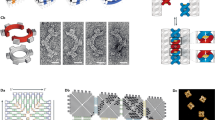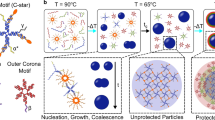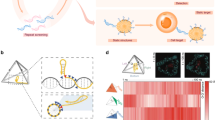Abstract
DNA is proving to be a powerful scaffold to construct molecularly precise designer DNA devices. Recent trends reveal their ever-increasing deployment within living systems as delivery devices that not only probe but also program and re-program a cell, or even whole organisms. Given that DNA is highly immunogenic, we outline the molecular, cellular and organismal response pathways that designer nucleic acid nanodevices are likely to elicit in living systems. We address safety issues applicable when such designer DNA nanodevices interact with the immune system. In light of this, we discuss possible molecular programming strategies that could be integrated with such designer nucleic acid scaffolds to either evade or stimulate the host response with a view to optimizing and widening their applications in higher organisms.
This is a preview of subscription content, access via your institution
Access options
Subscribe to this journal
Receive 12 print issues and online access
$259.00 per year
only $21.58 per issue
Buy this article
- Purchase on Springer Link
- Instant access to full article PDF
Prices may be subject to local taxes which are calculated during checkout




Similar content being viewed by others
References
Jones, M. R., Seeman, N. C. & Mirkin, C. A. Programmable materials and the nature of the DNA bond. Science 347, 1260901 (2015). We recommend this paper as an introduction to advances in DNA nanotechnology.
Krishnan, Y. & Bathe, M. Designer nucleic acids to probe and program the cell. Trends Cell Biol. 22, 624–633 (2012).
Fu, Y. & He, C. Nucleic acid modifications with epigenetic significance. Curr. Opin. Chem. Biol. 16, 516–524 (2012).
Frost, L. S., Leplae, R., Summers, A. O. & Toussaint, A. Mobile genetic elements: the agents of open source evolution. Nature Rev. Microbiol. 3, 722–732 (2005).
Bickle, T. A. & Krüger, D. H. Biology of DNA restriction. Microbiol. Rev. 57, 434–450 (1993).
Makarova, K. S., Wolf, Y. I. & Koonin, E. V. Comparative genomics of defense systems in archaea and bacteria. Nucleic Acids Res. 41, 4360–4377 (2013).
Mao, S., Sun, W. & Kissel, T. Chitosan-based formulations for delivery of DNA and siRNA. Adv. Drug Deliv. Rev. 62, 12–27 (2010).
Xu, C.-X. et al. V-shaped dinuclear Pt(II) complexes: selective interaction with human telomeric G-quadruplex and significant inhibition towards telomerase. Sci. Rep. 3, 2060 (2013).
Guéron, M. & Leroy, J. L. The i-motif in nucleic acids. Curr. Opin. Struct. Biol. 10, 326–331 (2000).
Cutler, J. I., Auyeung, E. & Mirkin, C. A. Spherical nucleic acids. J. Am. Chem. Soc. 134, 1376–1391 (2012).
Rothemund, P. W. K. Folding DNA to create nanoscale shapes and patterns. Nature 440, 297–302 (2006).
Horvath, P. & Barrangou, R. CRISPR/Cas, the immune system of bacteria and archaea. Science 327, 167–70 (2010).
Goubau, D., Deddouche, S. & Reis e Sousa, C. Cytosolic sensing of viruses. Immunity 38, 855–869 (2013).
Wu, J. & Chen, Z. J. Innate immune sensing and signaling of cytosolic nucleic acids. Annu. Rev. Immunol. 32, 461–488 (2014). References 13 and 14 provide an overview of the mechanisms of detection of nucleic acids and related immune responses.
Ivashkiv, L. B. & Donlin, L. T. Regulation of type I interferon responses. Nature Rev. Immunol. 14, 36–49 (2014).
Eldridge, M. J. & Shenoy, A. R. Antimicrobial inflammasomes: unified signalling against diverse bacterial pathogens. Curr. Opin. Microbiol. 23, 32–41 (2015).
Lupfer, C., Malik, A. & Kanneganti, T.-D. Inflammasome control of viral infection. Curr. Opin. Virol. 12, 38–46 (2015). Host responses to nucleic acids via the interferon and caspase-1 inflammasome pathways are summarized in refs 15–17.
Desmet, C. J. & Ishii, K. J. Nucleic acid sensing at the interface between innate and adaptive immunity in vaccination. Nature Rev. Immunol. 12, 479–491 (2012).
Holm, C. K., Paludan, S. R. & Fitzgerald, K. A. DNA recognition in immunity and disease. Curr. Opin. Immunol. 25, 13–18 (2013).
Atianand, M. K., Rathinam, V. A. & Fitzgerald, K. A. SnapShot: inflammasomes. Cell 153, 272–272.e1 (2013).
Burdette, D. L. & Vance, R. E. STING and the innate immune response to nucleic acids in the cytosol. Nature Immunol. 14, 19–26 (2013).
Sun, L., Wu, J., Du, F., Chen, X. & Chen, Z. J. Cyclic GMP-AMP synthase is a cytosolic DNA sensor that activates the type I interferon pathway. Science 339, 786–791 (2013).
Ablasser, A. et al. cGAS produces a 2′-5′-linked cyclic dinucleotide second messenger that activates STING. Nature 498, 380–384 (2013).
Bhat, N. & Fitzgerald, K. A. Recognition of cytosolic DNA by cGAS and other STING-dependent sensors. Eur. J. Immunol. 44, 634–640 (2014).
Chiu, Y.-H., Macmillan, J. B. & Chen, Z. J. RNA polymerase III detects cytosolic DNA and induces type I interferons through the RIG-I pathway. Cell 138, 576–591 (2009).
Yang, P. et al. The cytosolic nucleic acid sensor LRRFIP1 mediates the production of type I interferon via a β-catenin-dependent pathway. Nature Immunol. 11, 487–494 (2010).
Wagner, H. The sweetness of the DNA backbone drives Toll-like receptor 9. Curr. Opin. Immunol. 20, 396–400 (2008).
Krieg, A. M. Therapeutic potential of Toll-like receptor 9 activation. Nature Rev. Drug Discov. 5, 471–484 (2006). Molecular determinants of TLR9-activating dsDNA and their potential application in vaccine design are discussed in refs 27 and 28.
Jin, T. et al. Structures of the HIN domain:DNA complexes reveal ligand binding and activation mechanisms of the AIM2 inflammasome and IFI16 receptor. Immunity 36, 561–571 (2012).
Gehrke, N. et al. Oxidative damage of DNA confers resistance to cytosolic nuclease TREX1 degradation and potentiates STING-dependent immune sensing. Immunity 39, 482–495 (2013).
Gilliet, M., Cao, W. & Liu, Y.-J. Plasmacytoid dendritic cells: sensing nucleic acids in viral infection and autoimmune diseases. Nature Rev. Immunol. 8, 594–606 (2008).
Huang, L. et al. Cutting edge: DNA sensing via the STING adaptor in myeloid dendritic cells induces potent tolerogenic responses. J. Immunol. 191, 3509–3513 (2013).
Radovic-Moreno, A. F. et al. Immunomodulatory spherical nucleic acids. Proc. Natl Acad. Sci. USA 112, 3892–3897 (2015).
Nagata, S. DNA degradation in development and programmed cell death. Annu. Rev. Immunol. 23, 853–875 (2005).
Atianand, M. K. & Fitzgerald, K. A. Molecular basis of DNA recognition in the immune system. J. Immunol. 190, 1911–1918 (2013).
Lee-Kirsch, M. A. et al. Mutations in the gene encoding the 3′-5′ DNA exonuclease TREX1 are associated with systemic lupus erythematosus. Nature Genet. 39, 1065–1067 (2007).
Crow, Y. J. et al. Mutations in the gene encoding the 3′-5′ DNA exonuclease TREX1 cause Aicardi-Goutières syndrome at the AGS1 locus. Nature Genet. 38, 917–920 (2006).
Kawane, K. et al. Chronic polyarthritis caused by mammalian DNA that escapes from degradation in macrophages. Nature 443, 998–1002 (2006).
Gall, A. et al. Autoimmunity initiates in nonhematopoietic cells and progresses via lymphocytes in an interferon-dependent autoimmune disease. Immunity 36, 120–131 (2012).
Stetson, D. B., Ko, J. S., Heidmann, T. & Medzhitov, R. Trex1 prevents cell-intrinsic initiation of autoimmunity. Cell 134, 587–598 (2008). The importance of DNAses in preventing systemic inflammation is discussed in this study.
Chitrabamrung, S., Rubin, R. L. & Tan, E. M. Serum deoxyribonuclease I and clinical activity in systemic lupus erythematosus. Rheumatol. Int. 1, 55–60 (1981).
Martínez Valle, F., Balada, E., Ordi-Ros, J. & Vilardell-Tarres, M. DNase 1 and systemic lupus erythematosus. Autoimmun. Rev. 7, 359–363 (2008).
Yoshida, H., Okabe, Y., Kawane, K., Fukuyama, H. & Nagata, S. Lethal anemia caused by interferon-β produced in mouse embryos carrying undigested DNA. Nature Immunol. 6, 49–56 (2005).
Ahn, J., Gutman, D., Saijo, S. & Barber, G. N. STING manifests self DNA-dependent inflammatory disease. Proc. Natl Acad. Sci. USA 109, 19386–19391 (2012).
Bhatia, D., Surana, S., Chakraborty, S., Koushika, S. P. & Krishnan, Y. A synthetic icosahedral DNA-based host–cargo complex for functional in vivo imaging. Nature Commun. 2, 339 (2011). The first description of tissue-specific cargo delivery in vivo using a DNA nanodevice.
Lee, H. et al. Molecularly self-assembled nucleic acid nanoparticles for targeted in vivo siRNA delivery. Nature Nanotech. 7, 389–393 (2012). This report describes a DNA nanodevice that delivers RNAi to tumours in vivo.
Surana, S., Bhat, J. M., Koushika, S. P. & Krishnan, Y. An autonomous DNA nanomachine maps spatiotemporal pH changes in a multicellular living organism. Nature Commun. 2, 340 (2011). The first designer DNA nanodevice that was delivered tissue-specifically in vivo where it functioned as a pH reporter.
Surana, S., Bhatia, D. & Krishnan, Y. A method to study in vivo stability of DNA nanostructures. Methods 64, 94–100 (2013).
Antony, A. C. Folate receptors. Annu. Rev. Nutr. 16, 501–521 (1996).
Liu, X. et al. A DNA nanostructure platform for directed assembly of synthetic vaccines. Nano Lett. 12, 4254–4259 (2012).
Gupta, S. et al. Oral delivery of therapeutic proteins and peptides: a review on recent developments. Drug Deliv. 20, 237–246 (2013).
Longmire, M., Choyke, P. L. & Kobayashi, H. Clearance properties of nano-sized particles and molecules as imaging agents: considerations and caveats. Nanomedicine 3, 703–717 (2008).
Ali, J. et al. Potential of nanoparticulate drug delivery systems by intranasal administration. Curr. Pharm. Des. 16, 1644–1653 (2010).
Dhuria, S. V., Hanson, L. R. & Frey, W. H. Intranasal delivery to the central nervous system: mechanisms and experimental considerations. J. Pharm. Sci. 99, 1654–1673 (2010).
Harmon, B. T. et al. Intranasal administration of plasmid DNA nanoparticles yields successful transfection and expression of a reporter protein in rat brain. Gene Ther. 21, 514–521 (2014).
Ding, X.-Q. et al. Ocular delivery of compacted DNA-nanoparticles does not elicit toxicity in the mouse retina. PLoS One 4, e7410 (2009).
Farjo, R., Skaggs, J., Quiambao, A. B., Cooper, M. J. & Naash, M. I. Efficient non-viral ocular gene transfer with compacted DNA nanoparticles. PLoS One 1, e38 (2006).
Ziady, A.-G. et al. Transfection of airway epithelium by stable PEGylated poly-L-lysine DNA nanoparticles in vivo. Mol. Ther. 8, 936–947 (2003).
Yurek, D. M. et al. DNA nanoparticles: detection of long-term transgene activity in brain using bioluminescence imaging. Mol. Imaging 10, 327–339 (2011).
Dai, H. et al. Chitosan-DNA nanoparticles delivered by intrabiliary infusion enhance liver-targeted gene delivery. Int. J. Nanomedicine 1, 507–522 (2006).
El-Sayed, A. & Harashima, H. Endocytosis of gene delivery vectors: from clathrin-dependent to lipid raft-mediated endocytosis. Mol. Ther. 21, 1118–1130 (2013).
Arteaga, C. L. & Engelman, J. A. ERBB receptors: from oncogene discovery to basic science to mechanism-based cancer therapeutics. Cancer Cell 25, 282–303 (2014).
Modi, S., Nizak, C., Surana, S., Halder, S. & Krishnan, Y. Two DNA nanomachines map pH changes along intersecting endocytic pathways inside the same cell. Nature Nanotech. 8, 459–467 (2013).
Saha, S., Prakash, V., Halder, S., Chakraborty, K. & Krishnan, Y. A pH-independent DNA nanodevice for quantifying chloride transport in organelles of living cells. Nature Nanotech. 10, 645–651 (2015).
Ewert, K. K. et al. Cationic liposome-nucleic acid complexes for gene delivery and silencing: pathways and mechanisms for plasmid DNA and siRNA. Top. Curr. Chem. 296, 191–226 (2010).
Doshi, N. & Mitragotri, S. Macrophages recognize size and shape of their targets. PLoS One 5, e10051 (2010).
Walsh, A. S., Yin, H., Erben, C. M., Wood, M. J. A. & Turberfield, A. J. DNA cage delivery to mammalian cells. ACS Nano 5, 5427–5432 (2011).
Bhatia, D. et al. Icosahedral DNA nanocapsules by modular assembly. Angew. Chem. Int. Ed. 48, 4134–4137 (2009).
Millart, H., Durlach, V. & Durlach, J. Red blood cell magnesium concentrations: analytical problems and significance. Magnes. Res. 8, 65–76 (1995).
Sobczak, J.-P. J., Martin, T. G., Gerling, T. & Dietz, H. Rapid folding of DNA into nanoscale shapes at constant temperature. Science 338, 1458–1461 (2012).
Wei, B., Dai, M. & Yin, P. Complex shapes self-assembled from single-stranded DNA tiles. Nature 485, 623–626 (2012).
Hahn, J., Wickham, S. F. J., Shih, W. M. & Perrault, S. D. Addressing the instability of DNA nanostructures in tissue culture. ACS Nano 8, 8765–8775 (2014).
Douglas, S. M. et al. Self-assembly of DNA into nanoscale three-dimensional shapes. Nature 459, 414–418 (2009).
Liedl, T., Högberg, B., Tytell, J., Ingber, D. E. & Shih, W. M. Self-assembly of three-dimensional prestressed tensegrity structures from DNA. Nature Nanotech. 5, 520–524 (2010).
Perrault, S. & Shih, W. Virus-inspired membrane encapsulation of DNA nanostructures to achieve in vivo stability. ACS Nano 8, 5132–5140 (2014).
Chen, J. H. & Seeman, N. C. Synthesis from DNA of a molecule with the connectivity of a cube. Nature 350, 631–633 (1991).
Keum, J.-W. & Bermudez, H. Enhanced resistance of DNA nanostructures to enzymatic digestion. Chem. Commun. 45, 7036–7038 (2009).
Conway, J. W., McLaughlin, C. K., Castor, K. J. & Sleiman, H. DNA nanostructure serum stability: greater than the sum of its parts. Chem. Commun. 49, 1172–1174 (2013).
Dohno, C., Okamoto, A. & Saito, I. Stable, specific, and reversible base pairing via Schiff base. J. Am. Chem. Soc. 127, 16681–16684 (2005).
Tomás-Gamasa, M., Serdjukow, S., Su, M., Müller, M. & Carell, T. 'Post-it' type connected DNA created with a reversible covalent cross-link. Angew. Chem. Int. Ed. 54, 796–800 (2015).
D'Alonzo, D., Guaragna, A. & Palumbo, G. Exploring the role of chirality in nucleic acid recognition. Chem. Biodivers. 8, 373–413 (2011).
Hyrup, B. & Nielsen, P. E. Peptide nucleic acids (PNA): synthesis, properties and potential applications. Bioorg. Med. Chem. 4, 5–23 (1996).
Leumann, C. J. Sugar modification as a means to increase the biological performance of oligonucleotides. Vol. 50 Nucleic Acids Symp. Series (Oxf). 55–56 (2006).
Liu, J. et al. Fabrication of stable and RNase-resistant RNA nanoparticles active in gearing the nanomotors for viral DNA packaging. ACS Nano 5, 237–246 (2011).
Uhlmann, E. Peptide nucleic acids (PNA) and PNA-DNA chimeras: from high binding affinity towards biological function. Biol. Chem. 379, 1045–1052 (1998).
Lesnik, E. A. & Freier, S. M. Relative thermodynamic stability of DNA, RNA, and DNA:RNA hybrid duplexes: relationship with base composition and structure. Biochemistry 34, 10807–10815 (1995).
Owczarzy, R., You, Y., Groth, C. L. & Tataurov, A. V. Stability and mismatch discrimination of locked nucleic acid-DNA duplexes. Biochemistry 50, 9352–9367 (2011).
Schüller, V. J. et al. Cellular immunostimulation by CpG-sequence-coated DNA origami structures. ACS Nano 5, 9696–9702 (2011).
Greenland, J. R. & Letvin, N. L. Chemical adjuvants for plasmid DNA vaccines. Vaccine 25, 3731–3741 (2007).
Huang, L. et al. Engineering DNA nanoparticles as immunomodulatory reagents that activate regulatory T cells. J. Immunol. 188, 4913–4920 (2012).
Kaminski, J. J. et al. Synthetic oligodeoxynucleotides containing suppressive TTAGGG motifs inhibit AIM2 inflammasome activation. J. Immunol. 191, 3876–3883 (2013). This report identified DNA motifs that could be used to inhibit the AIM2 receptor-dependent inflammatory pathways.
Engelmann, I. & Pujol, N. Innate immunity in C. elegans. Adv. Exp. Med. Biol. 708, 105–121 (2010).
Hoffmann, J. A. The immune response of Drosophila. Nature 426, 33–38 (2003).
Novoa, B. & Figueras, A. Current topics in innate immunity II. Advances in experimental medicine and biology 946, 253–275 (2012).
Langevin, C. et al. The antiviral innate immune response in fish: evolution and conservation of the IFN system. J. Mol. Biol. 425, 4904–4920 (2013).
Douglas, S. M., Bachelet, I. & Church, G. M. A logic-gated nanorobot for targeted transport of molecular payloads. Science 335, 831–834 (2012). This paper describes a DNA cargo-hold that delivers payloads triggered by molecular logic.
Zhao, Y. -X. et al. DNA Origami delivery system for cancer therapy with tunable release properties. ACS Nano 6, 8684–8691 (2012).
Lee, J. B. et al. Multifunctional nanoarchitectures from DNA-based ABC monomers. Nature Nanotech. 4, 430–436 (2009).
Kim, D.-N., Kilchherr, F., Dietz, H. & Bathe, M. Quantitative prediction of 3D solution shape and flexibility of nucleic acid nanostructures. Nucleic Acids Res. 40, 2862–2868 (2012).
Pan, K. et al. Lattice-free prediction of three-dimensional structure of programmed DNA assemblies. Nature Commun. 5, 5578 (2014).
He, Y. et al. Hierarchical self-assembly of DNA into symmetrical supramolecular polyhedra. Nature 452, 198–201 (2013).
Goodman, R. P. et al. Rapid chiral assembly of rigid DNA building blocks for molecular nanofabrication. Science 310, 1661–1665 (2005).
Acknowledgements
A.R.S. acknowledges funds from the Royal Society (RG130811), the Wellcome Trust and Imperial College London start-up funds. Y.K. acknowledges the Wellcome-Trust DBT India Alliance (500095/Z/09/Z), HFSP Organisation (RGP0029/2014) and the University of Chicago start-up funds. The authors are grateful to A. Turberfield and J. Bath for high-resolution versions of Fig. 4(i). We appreciate feedback from numerous colleagues, and sincerely apologize to those authors whose work could not be included due to space limitations. In memory of our inspirational colleague, the late Professor Obaid Siddiqi.
Author information
Authors and Affiliations
Contributions
All authors contributed equally in writing the manuscript.
Corresponding authors
Ethics declarations
Competing interests
The authors declare no competing financial interests.
Rights and permissions
About this article
Cite this article
Surana, S., Shenoy, A. & Krishnan, Y. Designing DNA nanodevices for compatibility with the immune system of higher organisms. Nature Nanotech 10, 741–747 (2015). https://doi.org/10.1038/nnano.2015.180
Received:
Accepted:
Published:
Issue Date:
DOI: https://doi.org/10.1038/nnano.2015.180
This article is cited by
-
A temporally resolved DNA framework state machine in living cells
Nature Machine Intelligence (2023)
-
Detecting organelle-specific activity of potassium channels with a DNA nanodevice
Nature Biotechnology (2023)
-
Dynamic matrices with DNA-encoded viscoelasticity for cell and organoid culture
Nature Nanotechnology (2023)
-
Single-molecule analysis of DNA base-stacking energetics using patterned DNA nanostructures
Nature Nanotechnology (2023)
-
Dynamic regulation of DNA nanostructures by noncanonical nucleic acids
NPG Asia Materials (2021)



